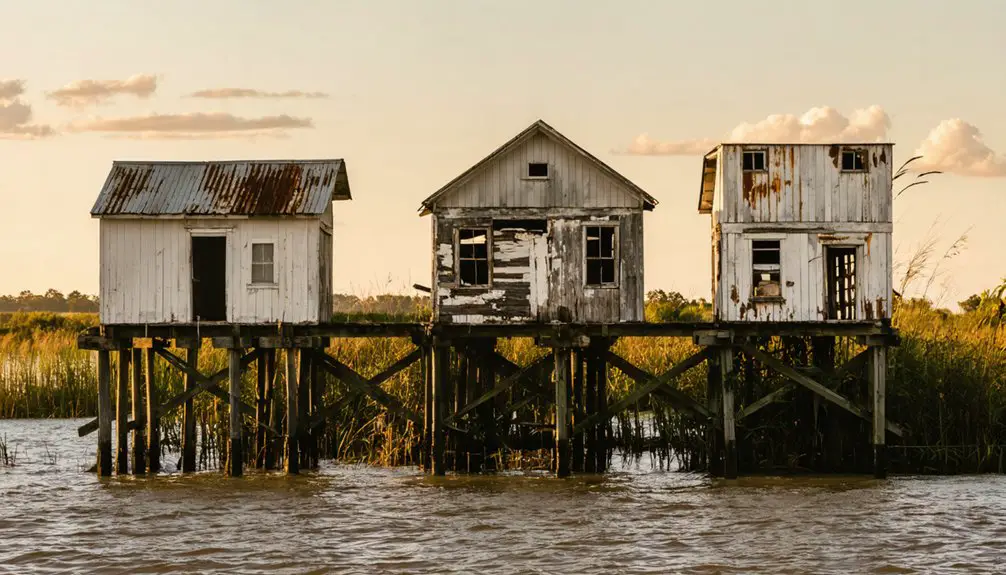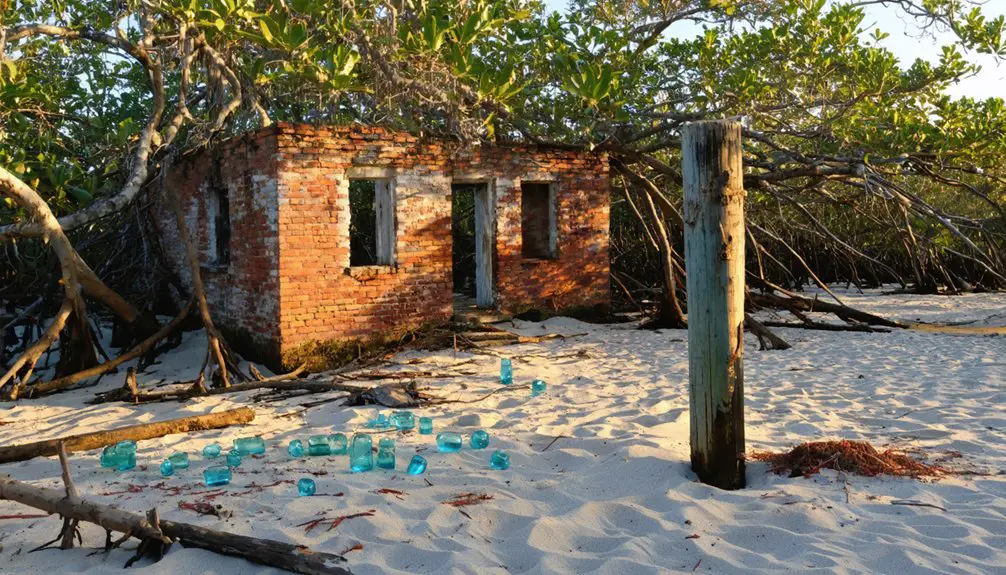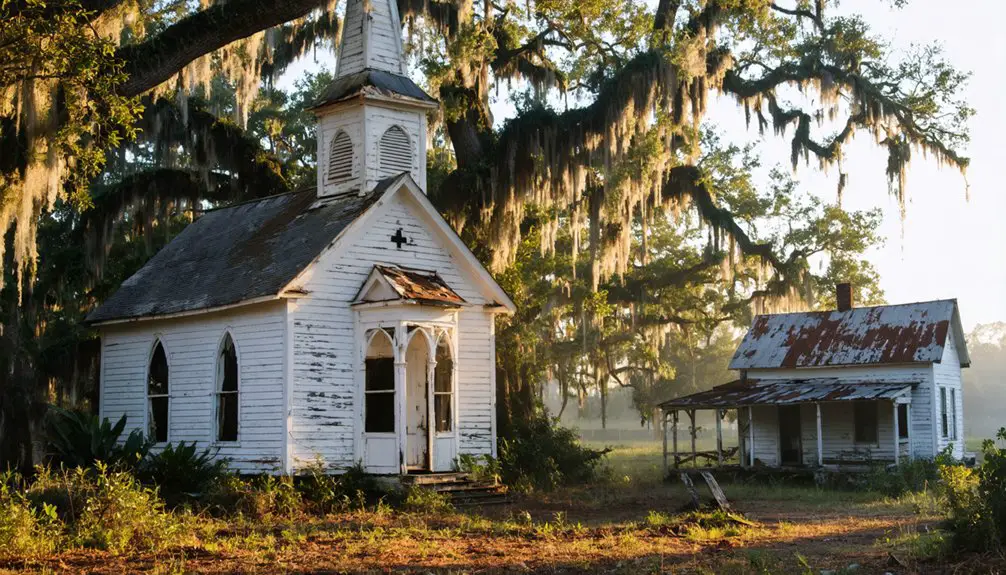You’ll find Bayview’s ghost town ruins along Tampa Bay’s western shore, where the McMullen family first settled in 1845. The pioneer settlement thrived through cattle ranching, citrus farming, and maritime trade until the railroad’s bypass led to its decline. Today, you can explore historic trails revealing old wharf pilings, pioneer-era structures, and the mysterious Bayview Cemetery. The site’s archaeological discoveries and local legends offer compelling glimpses into Florida’s frontier past.
Key Takeaways
- Bayview was established in 1845 along Tampa Bay’s western edge by James McMullen and early settlers as a farming community.
- The settlement thrived through cattle ranching, citrus cultivation, and maritime trade until urban development shifted activities in the 1960s.
- Original structures from 1900-1926 remain standing, including historic homes and remnants of the commercial wharf known as “Shipping Pen.”
- The town declined after being bypassed by the railroad, transforming from a bustling waterfront settlement into a ghost town.
- Archaeological discoveries and preserved pioneer-era buildings in Heritage Village document Bayview’s rich historical significance.
Early Settlement and Pioneer Life
While the Seminole Indians initially inhabited the area, Bayview’s formal settlement began in 1845 along Tampa Bay’s western edge, just south of Safety Harbor.
The settlement history started with James McMullen, his brothers, and Elias Hart, who established themselves as farmers and cattle ranchers.
You’ll find that these early settlers faced significant pioneer challenges – they were technically squatters until the Armed Occupation Act of 1842 legitimized their claims. This legislation granted 160 acres to those willing to bear arms, live on, and cultivate the land for five years.
Life wasn’t easy; settlers endured Seminole attacks, including the burning of their cabins, and had to rebuild their homesteads in the wilderness. Their survival depended on self-sufficiency and cooperation with fellow pioneers.
James McMullen later revolutionized the citrus industry by creating the first orange crate in Florida.
The area’s deep water access proved invaluable for the early settlers, enabling efficient transportation of their cattle and citrus crops to distant markets.
The McMullen Family Legacy
You’ll find the McMullen brothers’ pioneer legacy deeply woven into Bayview’s history, as seven siblings settled across the Pinellas Peninsula between 1841 and 1871.
Their agricultural ventures evolved from initial cattle ranching and cotton farming to establishing some of the area’s first productive citrus groves, while William McMullen developed the peninsula’s first commercial saltworks.
Through both peaceful and turbulent times, including the Civil War period when James and Daniel McMullen supplied Confederate troops through “Cow Cavalry” operations, the family maintained and expanded their landholdings to create lasting settlements across the region. Just like the evolution from traditional newspapers to digital media platforms, the McMullen family adapted to changing times while preserving their cultural heritage.
Pioneer Settlement Challenges
As Captain Jim McMullen established Bayview in the 1870s, his family faced formidable challenges that would test their pioneering spirit.
You’d have found pioneer struggles at every turn, from the swampy terrain near Alligator Creek to the dense wilderness that isolated the settlement.
Early transportation proved especially difficult, with limited access to supplies and a heavy reliance on steamboat deliveries. Like many settlements along the waterways, the St. Johns River was vital for trade and survival. The family had previously lost their first cabin when it was burned by Seminoles during their absence.
- Dense wilderness and swampland made land clearing and building extremely challenging
- Primitive wooden structures offered little protection from Florida’s harsh weather
- Limited transportation routes forced dependence on unreliable steamboat shipments
- Initial isolation meant scarce access to basic necessities and social institutions
The McMullens tackled these obstacles head-on, building the first road across Alligator Creek and constructing a wharf to improve access to crucial trade routes.
Land Development and Ranching
Seven McMullen brothers laid the foundation for Bayview’s agricultural empire between 1841 and 1871, transforming the untamed Pinellas Peninsula into a thriving network of homesteads and ranches.
You’ll find their legacy in the strategic land use patterns they established, from Daniel’s 160-acre homestead near Largo to James’s prime Bayview settlement.
The brothers didn’t just claim land – they maximized it. They ran extensive cattle operations, established essential saltworks, and later pivoted to lucrative citrus farming.
Their community growth efforts centered on Bayview’s deepwater access, though the anticipated railway boom never materialized.
Despite facing Seminole attacks and Civil War disruptions, the McMullens’ agricultural ventures prospered, with their cattle supplying Confederate troops as part of the “Cow Cavalry” during the war.
Conflict With Seminole Tribes
Throughout its early history, Bayview’s development was considerably shaped by the broader Seminole Wars that ravaged Florida from 1816 to 1858.
You’ll find that the town’s early settlers faced ongoing tensions due to U.S. encroachment into traditional Seminole territories. The area witnessed sporadic guerrilla warfare as Seminole resistance intensified, especially during the Second Seminole War (1835-1842). General Andrew Jackson’s forces had previously destroyed numerous native settlements in the region during the First Seminole War. Under the leadership of Osceola, Seminole warriors fiercely resisted removal efforts and frequently engaged U.S. troops.
Early settlers of Bayview endured constant tensions with Seminole tribes as territorial disputes erupted into guerrilla warfare during the 1830s.
- Local ranchers and homesteaders frequently reported raids on their cattle and property
- Military patrols from nearby Fort Myers regularly passed through Bayview to monitor Seminole activities
- The Armed Occupation Act of 1842 accelerated white settlement in the area, despite ongoing conflicts
- Several skirmishes occurred near Bayview’s boundaries as Seminoles retreated further into the Everglades
The tensions didn’t fully subside until after 1858, when most remaining Seminoles had either relocated or withdrawn deep into South Florida’s wilderness.
Agricultural Development and Ranching
When early settlers arrived in Bayview during the mid-1800s, they quickly recognized the area’s potential as a strategic shipping port for cattle.
You’d find ranchers driving their herds through the settlement to the deep harbor, where they’d swim the cattle to waiting boats bound for Tampa’s markets.
As the century progressed, farmers discovered more profitable opportunities in citrus cultivation.
Similar to how the Victorian summer colony thrived seasonally in Michigan’s Bay View, this Florida settlement maintained a bustling agricultural presence from spring through fall.
James McMullen’s citrus innovations, including Florida’s first orange crate, revolutionized fruit shipping. The area’s farmers later introduced the Murcott tangerine, while building partnerships with steamboat operators to reach Gulf ports.
Despite the ranching challenges of maintaining cattle routes through the growing settlement, both industries initially thrived.
The construction of Alligator Creek bridge and a commercial wharf supported this agricultural boom until the 1960s, when devastating freezes pushed farmers to sell their land for urban development.
Historical Landmarks and Structures

Modern visitors to Bayview can still find several historical structures that tell the story of this once-thriving settlement.
You’ll discover homes from the 1920s-1940s showcasing unique architectural styles of Tampa Bay’s pioneer communities. The waterfront area reveals old wharf pilings that highlight Bayview’s maritime heritage as “Shipping Pen,” while church properties feature a notable 1918 dwelling that once hosted community gatherings. Metal detecting enthusiasts regularly use historical aerial maps to locate promising sites around these structures. Similar to Centralia’s massive commissary, Bayview had its own bustling commercial district that supplied goods to the entire region.
- Several homes built between 1900-1926 remain standing, offering glimpses into early 20th-century life
- James McMullen’s original cabin was preserved at Heritage Village in the 1990s
- An Indian midden site provides evidence of pre-settlement indigenous activity
- Historic church buildings served as both religious and social gathering spaces, though many haven’t survived
Geographic Features and Natural Landscape
You’ll find Bayview nestled along Tampa Bay’s western shore, where low-lying coastal plains meet the waters of this expansive estuary.
The site’s natural landscape features sandy coastal soils, wetland marshes, and remnants of native vegetation including saw palmettos and mangroves that once dominated the shoreline.
The area’s proximity to the Gulf Intracoastal Waterway and its position near historic shell mounds speaks to its long-standing significance as a coastal settlement.
Coastal Bay Features
Four distinct coastal features define Bayview’s unique geographic landscape: extensive bays, coastal marshes, complex sediment transport systems, and karst topography.
You’ll find vast bay ecosystems stretching across thousands of acres, with subtle rims that barely rise above the surrounding terrain. These dynamic systems work in harmony with sediment transport processes, where waves interact with the seafloor to shape the coastline’s evolution.
- Bay formations showcase diverse origins, from sea currents to potential extraterrestrial impacts
- Seagrass meadows and oyster reefs create vibrant aquatic habitats within the bays
- Coastal marshes extend narrowly inland but stretch across 280 miles of shoreline
- Karst features, including sinkholes, influence the region’s complex hydrology
The intricate interplay of these features creates a resilient yet vulnerable coastal environment that’s shaped Bayview’s distinctive character through time.
Natural Terrain Formations
Nestled within Florida’s distinctive terrain, Bayview’s natural landscape showcases elevated homestead sites that rise above the surrounding wetlands and forest floor.
You’ll find gently rolling hills and ridges that once supported early settlements, including the historically significant Indian Midden Black Mound – a unique natural formation in Pinellas County that’s largely disappeared due to development.
The terrain features blend dense thickets of saw palmettos and scrub pines with towering oaks that stand as natural landmarks.
Small ponds and seasonal creeks dot the landscape, while sandy, well-drained soils characterize the area’s foundation.
The natural formations have evolved as farming ceased, allowing forest to reclaim old agricultural clearings, though modern highways and urban development have permanently altered some of the original landscape contours.
Archaeological Discoveries and Artifacts

Three major archaeological excavations at Bayview between the 1920s and 1990s have revealed an extraordinary collection of well-preserved human remains and artifacts.
Major excavations spanning seven decades have uncovered remarkable artifacts and human remains at the historically significant Bayview site.
You’ll find evidence of complex burial practices spanning several centuries during the Middle Archaic period, with fascinating discoveries of life-sized wooden animal carvings deposited in pond mortuaries.
The site’s archaeological significance extends beyond human interments to include craft production areas and structural remains.
- Wooden and bone tools, shell beads, and carved animal figures indicate both daily life activities and ritual purposes
- Well-preserved human remains in peat deposits reveal sophisticated mortuary traditions
- Manufacturing areas show evidence of craft production during Manasota and Safety Harbor periods
- Post mold patterns suggest organized settlement structures related to both everyday and ceremonial activities
Preservation Efforts and Heritage Tourism
In your exploration of Bayview’s preservation initiatives, you’ll find that Heritage Village carefully relocated and restored several pioneer-era log cabins from the original settlement.
Detailed mapping efforts have documented the historical layout of Bayview’s streets, structures, and natural features, creating an invaluable record for future generations.
Archaeological sites receive special protection through controlled access measures and monitoring systems, ensuring that remaining artifacts and cultural deposits stay preserved in their original context.
Heritage Village Cabin Relocation
After decades of deterioration and multiple arson attacks, the historic McMullen-Coachman Cabin found new life through its relocation to Heritage Village in 1978.
The cabin’s preservation techniques included sandblasting charred logs and replacing compromised materials while maintaining historical authenticity. Federal CETA program workers spent years meticulously restoring both the exterior and interior, ensuring this essential piece of cabin history would survive for future generations.
- Built in 1852 by James and Elizabeth McMullen as one of the earliest settler structures
- Served as a representation of pioneer life, farming, and post-Civil War trade with Cuba
- Restoration showcased period construction methods using durable cypress wood
- Elizabeth McMullen’s role as the area’s first midwife adds social historical significance
Today, you’ll find this preserved pioneer dwelling serving as a cornerstone of Heritage Village’s living history exhibits.
Historic Mapping Documentation
Maps from 1845 onward document Bayview’s transformation from a thriving waterfront settlement to today’s ghost town, with seventeen historic maps highlighting key landmarks, homesites, and trails.
You’ll find early settlement patterns traced through James McMullen’s and Elias Hart’s accounts, which correlate with mapped locations of original cabins and ranches.
Modern preservation efforts combine digital and physical archives, with GIS technology breathing new life into historical cartography.
You can explore these records through Pastmaps’ digital platform, where historic maps are georeferenced to contemporary coordinates.
The City of Clearwater Archives maintains original mapping documentation, while innovative mapping techniques help protect archaeological sites.
These resources don’t just preserve history – they’re actively used to develop heritage trails and guided tours, keeping Bayview’s story alive for future generations.
Archaeological Site Protection
The rich archaeological heritage of Bayview demands sophisticated preservation strategies, combining both modern protection methods and public engagement initiatives.
You’ll find that archaeological ethics guide the site management approach, where professionals and volunteers work together to protect significant cultural resources dating from A.D. 450 to 1100.
County-acquired land and state grants guarantee physical protection of shell middens and burial sites, while managed public access supports preservation through education and awareness.
- Archaeological testing confirms high site integrity despite past unauthorized digging
- Public archaeology projects engage Native Americans, volunteers, and professionals
- Heritage tourism activities balance visitor access with conservation needs
- Educational programs, including national scholar lectures, foster community support for preservation
Maps and Trail Exploration Guide
For those seeking to explore Bayview’s forgotten paths, seventeen detailed historic maps offer an invaluable window into this Florida ghost town’s past.
You’ll discover historic routes leading to 1920s home sites, old wharfs, and Indian middens. These maps reveal former roadways and trails that you can still traverse today.
You’ll want to combine GPS technology with paper maps, as digital signals can be unreliable in remote areas.
While exploring these historic routes, you’ll find dock pilings, building foundations, and architectural remnants near county parks and church grounds.
Your exploration techniques should account for Florida’s climate – plan visits during cooler months for the best experience.
Most trails require moderate hiking ability, and you’ll need to navigate carefully using map overlays to locate ghost town features.
Local Legends and Cultural Impact

While pioneer towns often fade into obscurity, Bayview’s rich folklore and cultural legacy continue to captivate history enthusiasts today.
Though many frontier settlements vanish with time, Bayview’s enduring legends and heritage still enchant those who seek historical treasures.
You’ll discover a tapestry of local folklore woven from tales of Seminole conflicts, innovative orange crates, and the haunting presence of Bayview Cemetery. The town’s cultural resilience shines through stories of the McMullen family’s perseverance and early industrial ventures, even as economic hardships and natural disasters led to its eventual abandonment.
- Captain Jim McMullen’s original cabin, relocated to Heritage Village, stands as a symbol of pioneer ingenuity
- Ghost stories and paranormal activities reported at Bayview Cemetery draw curious visitors
- The town’s decline after the railroad bypass shaped regional development patterns
- Local historians preserve Bayview’s legacy through community heritage projects and storytelling initiatives
Frequently Asked Questions
What Caused the Eventual Decline and Abandonment of Bayview?
You’ll find economic downturns hit hard when railroads bypassed the town, while natural disasters and highway construction scattered the population. Modern development ultimately absorbed what remained of the original community.
Are There Any Remaining Unmarked Graves or Cemeteries in Bayview?
You won’t find documented evidence of unmarked graves or hidden cemeteries in the area today, though early settlement conditions and lack of formal records suggest burials could exist beneath the wooded landscape.
What Wildlife Species Were Commonly Hunted by Early Bayview Settlers?
You’d commonly hunt deer and wild turkey for sustenance, while also targeting alligators for their valuable hides. Bison and elk were pursued less frequently, with rabbits and squirrels providing year-round supplemental protein.
When Was the Last Known Permanent Resident Living in Bayview?
Like vanishing frontier spirits, you’ll find no definitive record of the last resident, though evidence suggests permanent inhabitants gradually disappeared by mid-20th century, leaving only ghost sightings and historical whispers behind.
Did Any Famous Outlaws or Notorious Criminals Pass Through Bayview?
You won’t find any records of famous outlaws or notorious criminals passing through Bayview. The town’s history centers on agriculture and commerce rather than criminal activity.
References
- https://www.ghosttowns.com/states/fl/bayview-pinellascounty.html
- https://pastmaps.com/explore/us/florida/bay-county/bayview/metal-detecting
- https://www.youtube.com/watch?v=kXGAKmjGMXg
- https://pastmaps.com/explore/us/florida/bay-county/bayview/hiking-exploration
- https://en.wikipedia.org/wiki/List_of_ghost_towns_in_Florida
- https://www.homes.com/local-guide/clearwater-fl/historic-bayview-neighborhood/
- https://www.youtube.com/watch?v=yO-0Z8R3EKg
- https://www.miami-history.com/p/early-stirrings-in-coconut-grove
- https://digitalcommons.usf.edu/cgi/viewcontent.cgi?article=1122&context=tampabayhistory
- https://digitalcommons.usf.edu/cgi/viewcontent.cgi?filename=7&article=4026&context=fac_publications&type=additional



